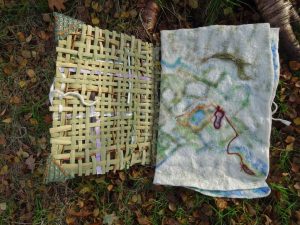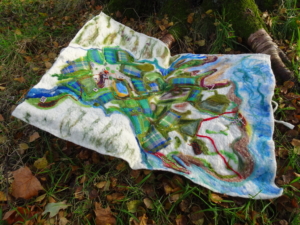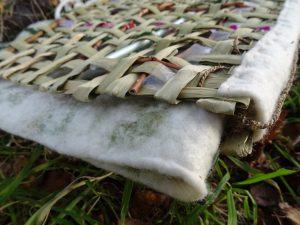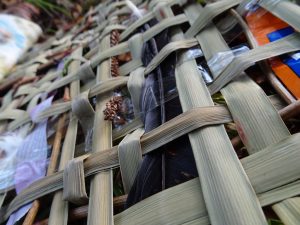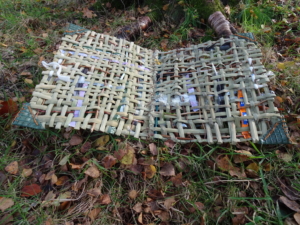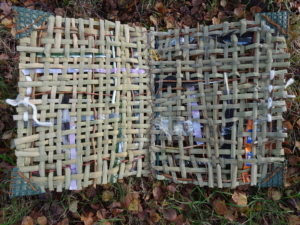Spread over my kitchen table, emptied from the various cloth bags and tubs, were the wild plants that I’d gathered that day. As I viewed them from above, deliberating as to what kind of meal I could make that would include them all, the array of textures conspired to suggest a visual record of the diverse habitats I’d encountered. In fact, with a bit of rearrangement, I could almost trace the route I’d taken in gathering them, the varied terrains represented through the materiality of the plants.
I pushed the long fleshy spears of sea plantain down to the edge of the table, arranging their seed heads in a cursory gesture towards the hand drawn waves of a map. The glossy green heart-shaped leaves of scurvy grass and the yellow flowers of sea radish served as the sandy dunes. Further inland (in-table?) I placed the small collection of mushrooms, charcoal burners mostly. Surrounding them with the sprigs of fresh pine needles – soon destined for the teapot – the forest habitat was completed with tiny bouquets of fast wilting woodland sorrel. The pale leaves gathered from the avenue of lime trees were layered over each other in approximation of the expansive park. Edged with the long lengths of reedmace that I’d taken from the lochside on my way back home – perhaps signified by my notebook in the centre of the table – the plants momentarily transformed the table-top into a topographical representation of their ecologies: an act of co-productive placemaking.
By the time I’d cooked up a noodle dish, blending a raw green pesto and stir-frying slices of fungi and reedmace together, the idea was starting to simmer within me. Seeing those distinct habitats of my local landscape represented first in plant form on the table, then in my bowl, and now feeling them integrate within my body, I had a feeling of taking a deep dive into the geographical and ecological relationships of this land.
The acts of gathering, eating, making and mapping became irrevocably linked.
These first stirrings towards ideas of mapping came as a natural extension and expression of an intensive period of deepening into the practice of harvesting wild food. I’d wanted to immerse myself in getting to know the edible plants around my local area of Castle Douglas, Dumfries and Galloway, where I was a fairly new resident. I chose a three-month period – between the season of wild strawberries to the first appearance of raspberries – within which I’d attempt to forage as much of my fresh food as was possible. Perhaps it was a way to introduce myself to the land, or to feel myself become present within the landscape through the embodied practice of foraging. Perhaps it was due in part to having a foraging ally – the amazing Mark Williams of Galloway Wild Food – living in the same area, and who was glad to share tips and enthusiasm. Exploring the edible edges of my surroundings as a daily practice, my encounters with plants, places and recipes came to be documented within a practice of writing and mapping.
During this period of consistently meeting and harvesting wild plants, the handling of their organic matter naturally shifted into possibilities of crafting with them. One afternoon, wet from the knees down and clutching a handful of reedmace freshly cut from the marshes, I’d returned to firm land to sit at a park picnic table to process the long stems of the plant. Separating the tender inner core of the reedmace – which tastes somewhat like a fibrous cucumber – the outer leaves piled up on the table beside me. Instead of discarding these tough leaves back into the edges of the loch-side, I lined up two leaves adjacent to each other and began tucking and weaving other leaves into relation with them, appreciating their thickly edged straightness, and the pleasing striations created by the pattern of green against green. A woman stopped to watch my process, asking over my shoulder if the weave would loosen as it dried. I replied that I didn’t know yet – that I was learning through the doing. But her suspicion was correct. As the two mats dried out back in my flat, steadily fading to pale ochre, the weave loosened, opening possibility for something else to be woven into the mix. A form of material experimentation began.

At other times, a plant which had passed beyond the season of edibility, such as the stems of mature nettles, suggested a practical use. Nettles gave opportunity to create cordage. I loved that process, stripping the nettle stem with bare hands if I dared, from top to bottom, then tapping down its length with a sturdy stick, paying more attention to its joints. Splitting open the core of the stem and removing the pith, the fibrous matter opens up, already dividing itself into threads to be twisted between fingers, or over thighs, to create a strong twine. As a longer length of twine was created, I began to imagine it being used to bind the reedmace mats together, allowing them to open and close like a book that seemed to be inviting a textile representation of the landscape to assemble within it.
The acts of gathering, eating, making and mapping became irrevocably linked. As my knowledge of the edible plants and varied habitats around my local area extended – into both my body and memory – the remnants of plants and collected materials began to be crafted and assembled in cartographical representation of the ecology I was engaging with. A foraged map of my foraging routes and relationships began to be created.

The Forager in the Landscape
Whilst human presence within a landscape is never without material repercussion, the bodily presence and sensory experience that is implicit within the act of foraging brings the forager into an acute awareness of a physical relationship with the environment, with each trajectory subtly altering the shape of the landscape. Through the act of picking fruit, collecting mushrooms, or gathering flowers, the forager becomes, as M. Kat Anderson names in Tending the Wild, ‘an active agent of environmental change.’ The forager impacts ecology whether through unconscious acts such as being used as the transportation device for the seed of a plant, or through conscious intent. The presence and activity of the forager has potential to be beneficial or harmful.
As an embodiment of ethical relationship with the environment, the forager is faced with distinct choices as to which species to harvest and how much to take. Through repetitive foraging within the same area, it is possible to witness the repercussions of previous actions and develop a relationship with specific plants, or habitats, which can be understood as a form of resource management. In Anderson’s study of indigenous Californian land management techniques, Tending the Wild: Native American Knowledge and the Management of California’s Natural Resources, understandings of ‘resource’ are interrogated, exposing the myth of ‘pristine virgin lands’ – as assumed within the writing of John Muir – wherein the biodiversity witnessed was due in part to the living dynamism of a sacred subsistence relationship between people and place. Becoming familial and entangled, the tending of a landscape for wild food or resources necessitates a renegotiation of conceptual distinctions made between understandings of ‘wilderness’ and ‘cultivation.’ For any forager who has tended the same patch of nettles throughout the year, resulting in a ‘cut and come again’ succession of green renewal, a similar dissolvement of boundaries has been experienced.
The relationship between forager and environment may evolve to encompass acts which go beyond the parameters of finding food, such as collecting litter, or planting wild fruit pips, providing possibility of developing a relationship of stewardship with the land. My foragings often confronted me with plastic matter. Releasing a mature tree from its outgrown protective guard presented me with reusable material that found new function in the making of the map. Collected food packaging, either picked up as litter or saved from the dried staples which supplemented my wild diet, became materials to be reinterpreted as creative resources. That the plants and discarded materials found within the area mapped came to be used within the process of creating the map, is a direct result of the nature of foraging: an active, hands-on process of experimentation and engagement with the world, as stimulated through curiosity and intimacy. The map as an artefact calls attention to the sharing of matter between an environment and a representational form or constructed notion of it: the felted enmeshment of a living landscape.

Felted Perspective
In understanding the perception and creation of the concept of landscape, or landskap; social anthropologist Tim Ingold highlights the etymological origins of the word – specifically the suffix – skap – as deriving from the Old English sceppan or skyppan, meaning ‘to shape.’ In his essay, ‘The Shape of the Land,’ Ingold draws attention to the fact that Medieval shapers of the land were not ‘artists or architects but farmers and woodsmen, whose purpose was not to lend ideal form to the material world, or to render it in appearance rather than substance, but to wrest a living from the earth.’
Within the relationship between land and land worker, Ingold situates the shaping of land as intrinsic to its constitution as is the weave to the fabric of woven cloth. Worked by plough, axe and with assistance of domesticated animals, this early agricultural shaping through visceral engagement with the earth contrasts sharply to our contemporary understanding of landscape with its more distanced, panoramic optic. Enforced through a predominance of societal reliance upon producing and maintenance of crops and farmland, agriculture etched and shaped a linearity into the landscape. With its ploughed furrows, stone dykes, access routes and field systems, the original agrarian shaping of land could be visually and metaphorically interpreted as the warp and weft of woven material, yet the applicability of any such shaping must also be afforded to peoples whose ways of life are less sedentary, such as the nomadic pastoralists and hunter-gatherers. Ingold makes use of an analogy accredited to Gilles Deleuze and Felix Guattari, who suggest that the way the land is worked within a nomadic pastoral or hunter- gathering culture might be better understood as that of the making of felt.
In 1440: The Smooth and the Striated in A Thousand Plateaus, Deleuze and Guattari present felt as the antifabric: ‘it implies no separation of threads, no intertwining, only an entanglement of fibres.’ In place of the linearity and striation of the farmed ground, the analogy of felt implies a smooth space comprising of the ‘entangled trajectories of growth and movement of people, plants and animals as they find a way through, following no predetermined direction but responding at every turn to the conditions of the moment and the possibilities they afford to carry on’ (Ingold, 198).
Whilst this analogy serves to frame the alternate shaping of landscapes as distinct to different cultural and historical relationships with land, it also serves to present a visual understanding of the mindset that creates the landscape, or the perception that perceives it. In this way, mindset and landscape become shaping forces upon each other, a concept articulated within the work of Scottish poet, Kenneth White who asks in ‘Meditation in Winter‘: ‘How to inaugurate and develop a thinking-in-the-territory (implicated in it, not imposed upon it)? Maybe thought can be like a landscape with fields and running waters (fluid concepts). A landscape-mindscape. That’s maybe what we could map our way towards.’ Playing through my thoughts and foragings, textiles of the land gathered in my hands and coalesced, assembling themselves gradually in accordance to my growing relationship with this specific territory.

Map Making Process
Weaving
As the reedmace mats dried out and loosened in their woven form, they needed reinforcing in order to retain their rigidity. I began to look for other materials to bring into the weave. In an area of common land on the outskirts of the town, stood a towering stand of robust, ruby coloured stems: Japanese knotweed. After standing to deliberate for some time, and checking for no signs of poisoning, I made my first cut. My actions had to be exact: any wastage of the plant matter could result in spreading the plant – a prosecutable offence. Whilst selecting stems of this plant which has generated an almost militaristic campaign towards its eradication, I began to wonder at the potential that such an ‘invasive’ plant might play within future ecologies.
Feathers and strands of litter add their own substrate to the weave, as they do to the land itself.
Through weaving Japanese knotweed and reclaimed materials alongside reedmace, with its long traditional usage within basketry and thatch, the woven outer cover of the map came to symbolise and question an expression of an environment in a perpetual state of becoming. With reedmace commonly torn from the edges of ponds in public spaces to prevent the process of water being woven into land, and Japanese Knotweed also holding edible and medicinal status, the movement towards presenting them as both food and material encourages a reconsideration of relationship with our most common, overlooked, or invasive plants.
In contrast, the long lengths of plantain stalks, woven with their seed heads still attached, were intentionally included to permit the spreading of seed as the map is opened. Their inclusion is an acknowledgement of the power of the plant to journey with human migration, utilising our movements for seed dispersal.
Feathers and strands of litter came to be interwoven alongside the plant materials, adding their own substrate to the weave, as they do to the land itself. The corners of the woven casing came to be edged with the reclaimed material of a broken tree guard; the material lending support beyond the remit of its purpose in the environment. Through this process of experimentation with a range of materials: ‘native’, ‘invasive’, ‘reclaimed’, the traditional handicraft of weaving encourages a consideration as to how we might perceive and work with the resources that present through our relationship with the world. Modular in form, the weaving offers potential to link with others.
Felting
The map was needle felted on my kitchen table, with a local felt artist introducing me to the tools and technique. A hand-held needle punch tool enabled me to entangle the fibres into the main body of felt, making a mechanical punching sound with each movement. From the 1950s, needle felting was used to make industrial felt on a large scale to be used within construction and fabrication of instruments, before being reinterpreted as a hand-held method by artisans in the 1980s. This enactment of making a representational landscape coincided with both industrial and artisan reinterpretations of the ancient technique of felting that dates back as far as 6300 BC as the oldest form of textile fabric.
Reclaimed fabric and plastic collected from the coastline came to be felted in alongside the wool fibres, with the act of felting entangling them into the body of the map, depicting the wider application of foraging as an act, connected as it is to associated practices such as scavenging and salvaging. Strands of my own hair – often collected from my hairbrush and distributed along the hedges as a tiny-giveback whilst foraging – became felted into the mix too: representative of the reciprocity of materials and nourishment exchanged between body and land.
Stitching
Each foraging route that I made by foot was then hand-stitched with thread, each stitch representing a trajectory through ecological entanglement. Road systems where left out of the map, although were sometimes made visible through the felted presence of verges and hedgerows. I stitched reference points, numbered onto handmade fungi paper, which related to specific foraged recipes inspired by the plants found in particular places. These recipes of time and place were ephemeral by nature, with the ingredients sometimes only overlapping in availability for a matter of weeks. The walking routes extended according to the unfolding of the season, venturing into an RAF bombing range along the coastline for seakale and seaweeds, or veering into woodlands for the beginning of the chanterelle season. The unmapped outer region of the map shows where my walking range finishes, suggesting the possibility for future explorations. As Donna Haraway has written: ‘The knowing self is partial in all its guises, never finished, whole, simply there and original; it is always constructed and stitched together imperfectly, and therefore able to join with another, to see together without claiming to be another’.

Of the Map / Off the Map
Engaging with Ingold’s notions of a ‘felted perspective’ informed my process of creating the map, thinking through the act of making. Each entanglement of fibre used within the felting process represented a trajectory of the self-willed matter of ecology: each fibre contributing to the form and strength of the whole. The felting action of the forager within an environment becomes paramount to the mindscape which this map reveals. The visceral engagement creates a shared materiality between land, forager and map.
Seen from below, the map reveals only the felted areas – the places of greatest biodiversity where root systems penetrate the earth most deeply. If a person engaging with the map was to hold it above their head, it could provide a symbolic inner earth perspective: a root map. The woven fields are not visible from this perspective, with only the felted fibres of edges, hedges, woodlands and coastline showing through, along with the stitched trajectories of my foragings. Viewing the map from this side, it becomes evident that these foragings are spread sparsely across the landscape, and that the felted areas are small and fragile within a region dominated by fields of grazing land.
Yet seen from above, the relationship between the felted and the woven – as with the conceptual divide between wilderness and cultivation – begins to blur. In reco (Ingold, p. 201)gnising that the divide between smooth and striated could never be as decisive as Deleuze and Guattari’s analogy perhaps implies, Ingold contends that ‘we are not, then, dealing with an opposition so much as with two ways of being that coexist in a tension that may be constructive or destructive’.
Mapping the place which has sustained my foraging reveals the shared bodyscape of self and land.
Mapping the place which has sustained my foraging reveals the shared bodyscape of self and land: the area described being the source of all wild food my body has incorporated within this research period, and so maps a geographical relationship to my own personal ecology. I began to extend White’s analogy to become ‘landscape-mindscape-bodyscape’ in recognition of the embodied processes made evident within the act of foraging. The map has taken on the relationship held between my body and the land through the practices of walking, eating, mapping and making, representative of the absolute shared materiality and connection between body and earth. Recognising matter’s narrative power, the map becomes a text, co-produced by plants, place and myself. Through partial functionality, the map remains an artefact of use, relating to but not solely positioned within the realm of art.
Foraging forms a way of gathering and creating a sense of place, building familiarity and intimacy with a landscape which provides direct source of sustenance, nourishment, and kinship. These particular foragings; compounded by the integrated practice of writing, researching, making and mapping; have taught me the depth to which a sense of place can enter my being. Whilst ‘sense of place’ is unravelled by questions of scale and globalised systems, the relationship between forager and place must remain ever adaptive. The depth of relating to this particular place shall now journey with me, beyond my relating to the area which I have mapped. New opportunities for foraging will present wherever I am, with familiar plants travelling alongside, and new regions offering opportunity to meet with particular species. In an age of increasing migration and human displacement around the planet, foraging retains its relevance as a form of situated knowledge through its power to create an eco-sensitivity, learnt through direct relation with place and plants, and internalised within the forager. As an embodied act, foraging prepares the forager with a certain resilience, knowledge set and appetite for connecting intimately with the earth
wherever they may go.
This is part of ROOT MAPPING, a section of The Learned Pig devoted to exploring which maps might help us live with a clear sense of where we are. ROOT MAPPING is conceived and edited by Melanie Viets.



